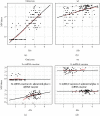Antibody Avidity and Neutralizing Response against SARS-CoV-2 Omicron Variant after Infection or Vaccination
- PMID: 36093434
- PMCID: PMC9453088
- DOI: 10.1155/2022/4813199
Antibody Avidity and Neutralizing Response against SARS-CoV-2 Omicron Variant after Infection or Vaccination
Abstract
Background: The recently emerged SARS-CoV-2 Omicron variant exhibits several mutations on the spike protein, enabling it to escape the immunity elicited by natural infection or vaccines. Avidity is the strength of binding between an antibody and its specific epitope. The SARS-CoV-2 spike protein binds to its cellular receptor with high affinity and is the primary target of neutralizing antibodies. Therefore, protective antibodies should show high avidity. This study aimed at investigating the avidity of receptor-binding domain (RBD) binding antibodies and their neutralizing activity against the Omicron variant in SARS-CoV-2 infected patients and vaccinees.
Methods: Samples were collected from 42 SARS-CoV-2 infected patients during the first pandemic wave, 50 subjects who received 2 doses of mRNA vaccine before the Omicron wave, 44 subjects who received 3 doses of mRNA vaccine, and 35 subjects who received heterologous vaccination (2 doses of adenovirus-based vaccine plus mRNA vaccine) during the Omicron wave. Samples were tested for the avidity of RBD-binding IgG and neutralizing antibodies against the wild-type SARS-CoV-2 virus and the Omicron variant.
Results: In patients, RBD-binding IgG titers against the wild-type virus increased with time, but remained low. High neutralizing titers against the wild-type virus were not matched by high avidity or neutralizing activity against the Omicron variant. Vaccinees showed higher avidity than patients. Two vaccine doses elicited the production of neutralizing antibodies, but low avidity for the wild-type virus; antibody levels against the Omicron variant were even lower. Conversely, 3 doses of vaccine elicited high avidity and high neutralizing antibodies against both the wild-type virus and the Omicron variant.
Conclusions: Repeated vaccination increases antibody avidity against the spike protein of the Omicron variant, suggesting that antibodies with high avidity and high neutralizing potential increase cross-protection against variants that carry several mutations on the RBD.
Copyright © 2022 Francesca Dapporto et al.
Conflict of interest statement
F.D., A.M., and P.P. are employed by VisMederi Srl. M.L., E. Molesti are employed by VisMederi Research Srl. E. Montomoli is an external consultant and Chief Scientific Officer of VisMederi Srl and VisMederi Research Srl.
Figures



References
-
- Austin Ramzy V. W., Myers S. L., Goldman R., et al. Naming the coronavirus disease (COVID-19) and the virus that causes it. Brazilian Journal of Implantology And Health Sciences . 2020;2(3)
-
- World Health Organization. Tracking SARS-CoV-2 variants. 2022. https://www.who.int/en/activities/tracking-SARS-CoV-2-variants . - PubMed
-
- SARS-CoV-2 Variant Classifications and Definitions. Centers for disease control and prevention. 2021. https://www.cdc.gov/coronavirus/2019-ncov/variants/variant-classificatio... .
-
- Centers for Disease Control and Prevention. Science brief: omicron (B.1.1.529) variant. 2021. https://www.cdc.gov/coronavirus/2019-ncov/science/science-briefs/scienti... . - PubMed
MeSH terms
Substances
Supplementary concepts
LinkOut - more resources
Full Text Sources
Medical
Miscellaneous

